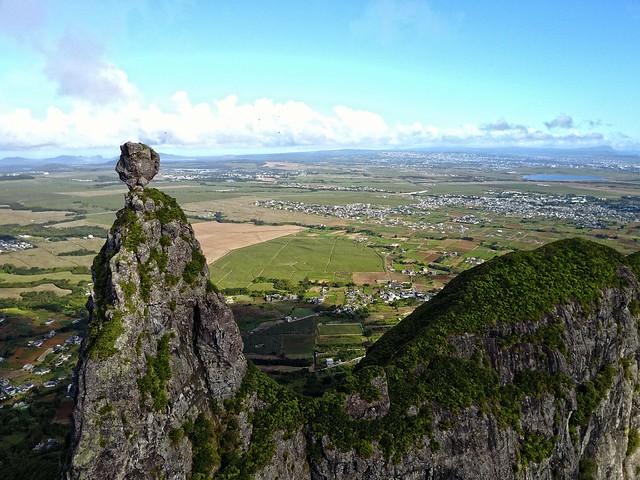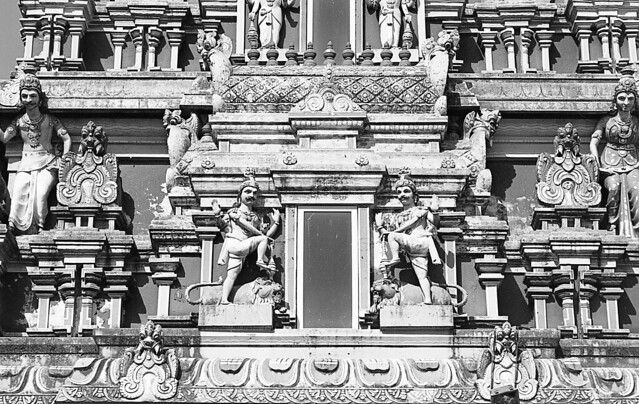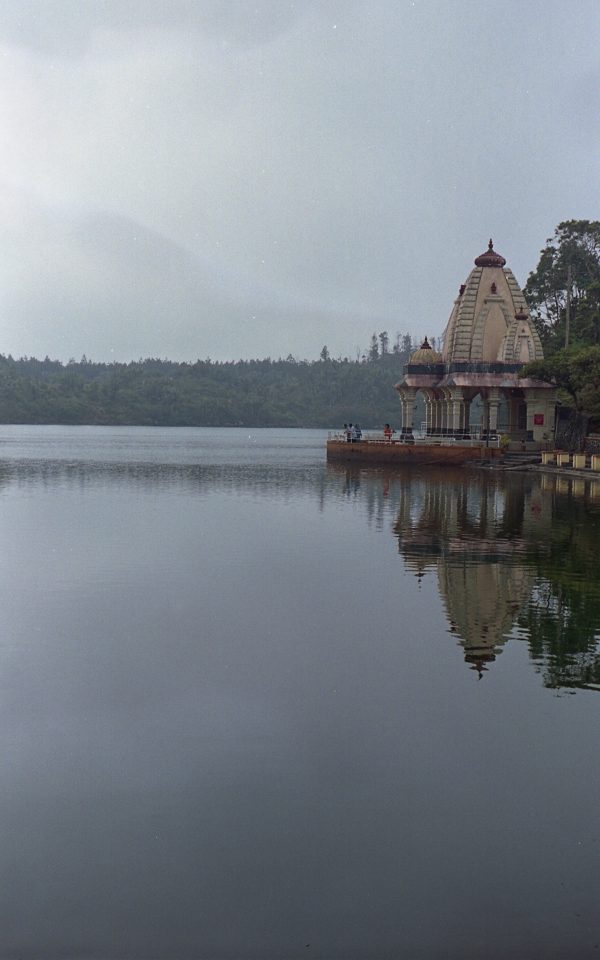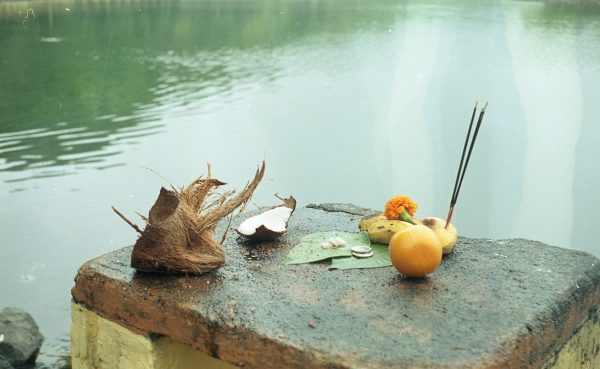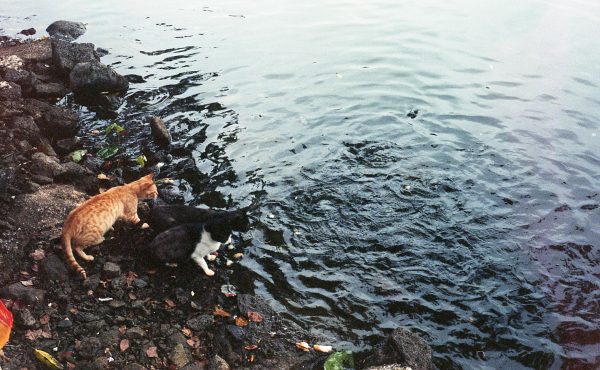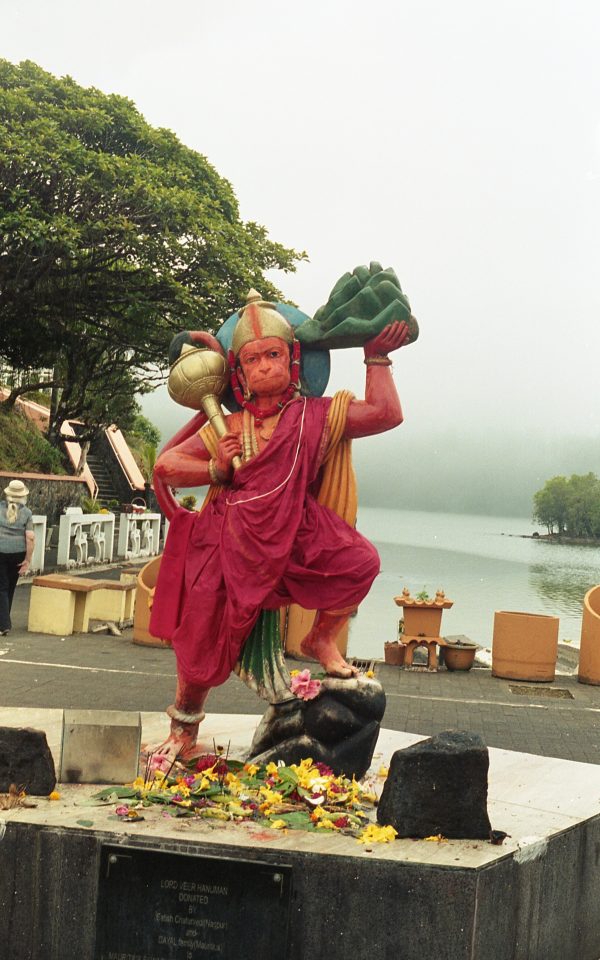We love Madagascar but from time to time we need a break – a change in scenery, a change in pace. Mauritius is great for that. It’s green, with a pleasant climate, and…nice. Mauritius has come a long way in a short time, and today boasts Africa’s highest Human Development Index. This post is a bit of a hodgepodge of our trips there – we’ve been there a few times – but hopefully it will highlight the variety and character of this small island nation off the eastern coast of Africa.
First, meet Pieter Both. No – not the first governor-general of the Dutch East Indies company in the late 1500s. I mean the second highest mountain (by 8 meters) in Mauritius. You can see this odd formation from much of the island – from some angles it looks like a part of the mountain is hovering above the rest. It can be climbed. If you do so, the last bit, a 30-foot rock perched on top, has handholds hammered into it that will allow you to climb onto the very top. There you can balance in the wind on a six-foot flat area with absolutely no handrails and survey the green fields as far as the eye can see. As far as the real Pieter Both, as far as I know, he never lived in Mauritius, which was a resupply point for the Dutch East Indies company as its ships traveled from the Netherlands to what is now Indonesia. In 1615, he left the Dutch East Indies for the last time, with four ships. Two of them sank off the coast of Mauritius, and he drowned. And that’s how the second highest peak on an island nation off the east coast of mainland Africa ended up getting named after some Dutch dude who lived in Indonesia 500 years ago.
The Portuguese discovered Mauritius, and weren’t interested in it. Mauritius became a Dutch colony in the 1500s. A rare case of a European colony established in a place that didn’t already have inhabitants. Then the French took over, and finally the English. As for the Dutch, they are responsible for the extinction, 75 years after its discovery, of the bird Mauritius’s beer is now named after: the dodo. I don’t think it was very tasty – it was nicknamed the “walgvogel,” or “disgusting bird,” but I guess if you’re hungry enough… Nowadays, there’s plenty of much tastier food. I guess that’s a French contribution.
The island is very ethnically diverse. Not only descendants of the colonists, but also former slaves – many from Madagascar – and half a million indentured laborers from India, brought in by the English after slavery was outlawed in 1835, resulting in a unique ethnic and religious tapestry. Looking at the island nowadays, it would appear that the group which left the biggest mark on the ethnic makeup of the island are the Indians. Everywhere we you go in Mauritius, you can see the ornate Hindu temples we came to know and appreciate in our time in Tamil Nadu.
Much of the work on Tamil temples, often carved by craftsmen brought from Tamil Nadu, is brightly colored and has a distinct style, like this representation of Ganesh, above. But other works were carved in black granite, or in more muted colors like the cat, below.
 And just like in Tamil Nadu, everyone was super friendly. They didn’t even get mad when we woke them up from an afternoon nap, even when we were trying to secretly take a picture of them napping.
And just like in Tamil Nadu, everyone was super friendly. They didn’t even get mad when we woke them up from an afternoon nap, even when we were trying to secretly take a picture of them napping.
The lake is peaceful in the low season – a quiet place for reflection, no matter what your religious beliefs. And yes, pun intended.
During one of our visits we discovered the Grand Bassin, a crater lake which, commonly known as “Ganga Talao” (Ganges pool), has become one of Hinduism’s largest pilgrimage sites. Hardly anyone was there when we visited, but if you carefully watch the video below, you’ll see the wide, paved walkway that has been laid parallel to the road. Imagine up to 400,000 people on that walkway, coming to visit the lake, make offerings, and worship at the temples that surround it.
https://www.youtube.com/watch?v=PxgARPAR67I?rel=0
The lake was discovered and designated a holy site by a Hindu priest in the late 1800s, but in 1972, sacred water from the Ganges was added, giving the lake its current name. You can read more about it here.
Even for non-Hindus, it’s not only pleasant but also quite fascinating to stroll around the lake and to see the countless offerings that have been made on the surrounding pillars, or to climb the stairs to a hilltop temple where you may spot a monkey or two, or the holy trees with strings winding around them or different artifacts and items left at their base by worshippers. The large quantity of food left by worshippers for the various Hindu gods ends up, to a large extent, in the lake. As a result, the lake supports a huge population of fish swirling in the water in all directions everywhere you look. And there is a clan of local cats which has mastered the art of catching these fish. Eager to see them in action, visitors will throw bread near the edge of the water, which sends them into a frenzy, and this in turn allows the patiently waiting cats to scoop them up in one quick movement. Once a cat catches a fish (often twice as wide as its head), it will dash off into the bushes, fish in mouth, to consume it before the competition shows up and demands a share.
This is a representation of Hanuman, the monkey god. With offerings at his feet. That’s correct – Hanuman is not an invention of the film “Black Panther.”
There are plenty of other things to do in Mauritius, of course. If you’re an American living in Madagascar, your interests may be different than the typical tourist – for us, a stop at McDonalds or a visit to a movie theater or shopping mall held a special attraction. But for everyone else, there are plenty of other things to do as well. Mauritius has beautiful beaches for swimming, diving, or just relaxing. As noted in a previous post, you can go out and actually swim with a pod of dolphins (video). You can take a relaxing drive through the countryside. Eat excellent food. Or you can go for a hike in the mountains – for hours and hours, if you like.
https://www.youtube.com/watch?v=a2kQQRhgAv4?rel=0
We also recommend the “adventure of sugar.” Mauritius’s agricultural land is covered with sugar cane, and the island has a long history of processing this cane into sugar…or rum! A now-defunct sugar refining/processing plant has been turned into a museum, where you can easily spend two to three hours learning all sorts of fascinating things about a food we all take for granted, and honestly, I never gave much thought. And at the end, you can sample over a dozen different types of sugar (honestly, I had no idea!) in addition to just as many varieties of rum. Bring a credit card, because you’ll definitely want to take home either some sugar, some rum, or both!
So that wraps up what we’ve experienced so far of Mauritius. If you visit this country, regardless what you choose to do, be sure and take a camera!

